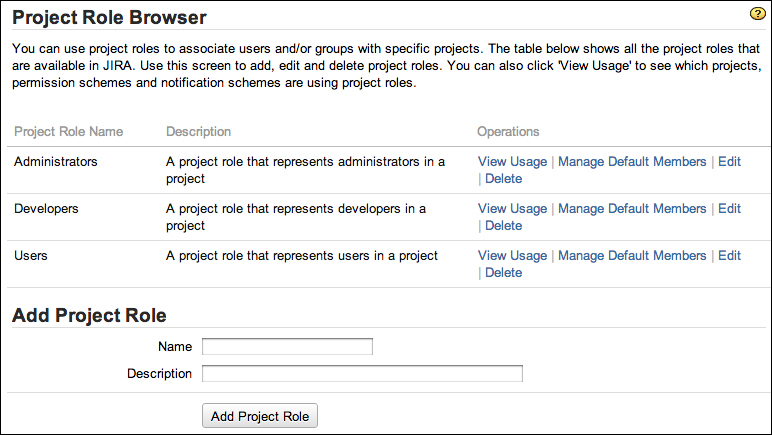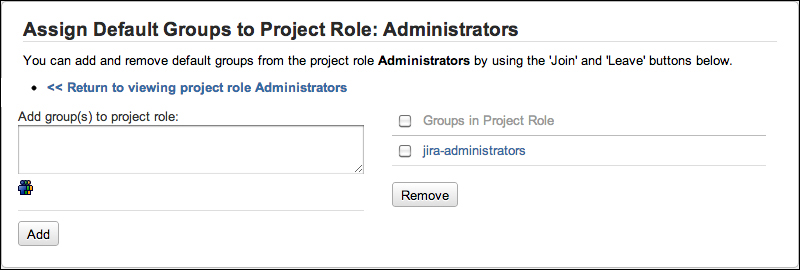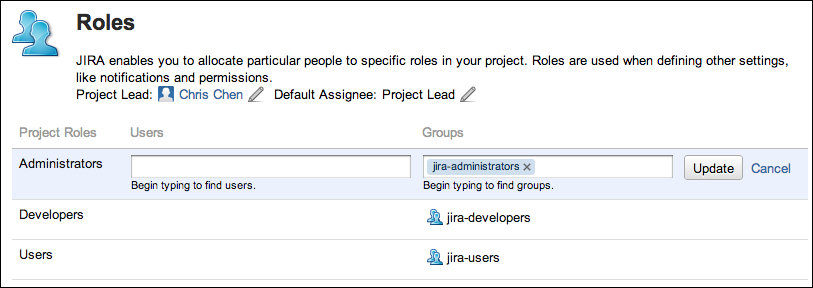As you have seen, groups are collections of users and are applied globally. JIRA offers another way of grouping users, which is applied on the project level only:
|
Project role |
Description |
|---|---|
|
Administrators |
This project role represents the administrator of the project (for example, project manager). |
|
Developers |
This project role represents the developer of the project. |
|
Users |
This project role represents the user of the project (for example, tester). |
Similar to users and groups, project roles are maintained by the JIRA administrator through the Project Role Browser. There is a slight difference, however, since project roles are specific to projects, JIRA administrators only define what roles are available in JIRA and their default members. Each project's administrators (discussed in later sections) can further define each role's membership for their own projects, overriding the default assignment. We will first look at what JIRA administrators can control through the Project Role Browser and then look at how project administrators can fine-tune the membership assignment later. Perform the following steps to access the Project Role Browser:
- Click on Administration in the top menu bar.
- Select Roles in the Users section to bring up the Project Role Browser page.

As an administrator, you can create new role types, which can then be used by project administrators for their projects. Perform the following steps to create a new project role type:
- Browse to the Project Role Browser page.
- Specify a unique name for the new project role in the Add Project Role section.
- Specify an optional description.
- Click on the Add Project Role button to create the project role.
Once you have added a new project role, it will appear for all the projects.
You can update a project role's name and description, as follows:
- Browse to the Project Role Browser page.
- Click on the Edit link for the project role you wish to update. This will take you to the Edit Project Role page.
- Specify a new name and description.
- Click on the Update button to apply the changes.
Existing project roles can be deleted if they are no longer used, as follows:
- Browse to the Project Role Browser page.
- Click on the Delete link for the project role you wish to remove. This will bring up the Delete Project Role page.
- Click on the Delete button to remove the project role.
As new projects are created in JIRA, it will often happen that those projects will share a similar security requirement. So, it becomes desirable to have default members assigned to the project roles when new projects are created.
Default members are an efficient way for JIRA administrators to assign project role members automatically, without having to manually manage each new project as they come in.
For example, by default, users in the jira-administrators group will have the Administrators project role. This increases the efficiency of the security setup by creating a baseline for new projects, but also offers the flexibility to allow modifications to the default setup to cater for unique requirements.
Perform the following steps to set default members for a project role:
- Browse to the Project Role Browser page.
- Click on the Manage Default Members link for the project role you wish to remove. This will take you to the Edit Default Members for Project Role: Administrators page.

In this page, you will see all the default members assigned to the selected project role. Default members can be logically assigned project roles based on the group setup. Users can be useful when you have exceptional cases, such as a lead developer that should have the Developers role in all software development projects.
Perform the following steps to add a default user/group for the project role:
- Click on the Edit link for the default member option (either user or group).
- Use the user picker/group picker function to select the users/groups you wish to assign to the project role.
- Click on the Add button to assign the role:

Once added, any new projects created will have the specified users/groups assigned to the project role. It is important to note that after you have set default members, only new projects will have the settings applied. Existing projects will not retrospectively have the default members applied.
As you have seen, JIRA allows you to assign default members to projects when they are created. This might be sufficient for most projects when they start. Changes will often need to be made due to staff movements throughout the project life cycle. While it is possible for the JIRA administrator to continue maintaining each project's membership, it can easily become an overwhelming task, and in most cases, since project roles are specific to each project, it makes sense to delegate this responsibility to the owner of each project.
In JIRA, an owner of a project is someone with the Administer Projects permission. By default, members of the Administrators' project role will have this permission. We will see in a later section how to manage permissions in JIRA.
As a project administrator, you will be able to assign members to the various project roles for your project. You can assign roles from the project administration page, as follows:
- Browse to the Project Administration page for the project you want to assign project roles for.
- Select the Roles tab.
- Click directly on either the Users or Groups column for the role you want to update in the assignment
- Use the user/group picker to search and select users/groups to assign to the project role.
- Click on the Update button.
The users and groups assigned to the project role will be for the current project only. You will have to reconfigure the members again for other projects. In this way, project role members are maintained separately for each project:

